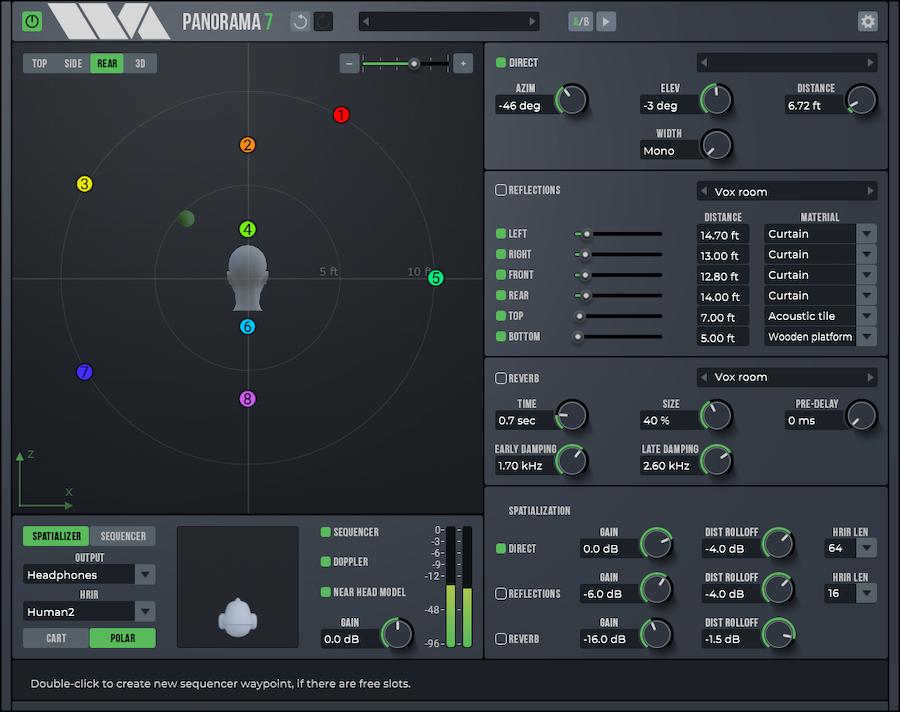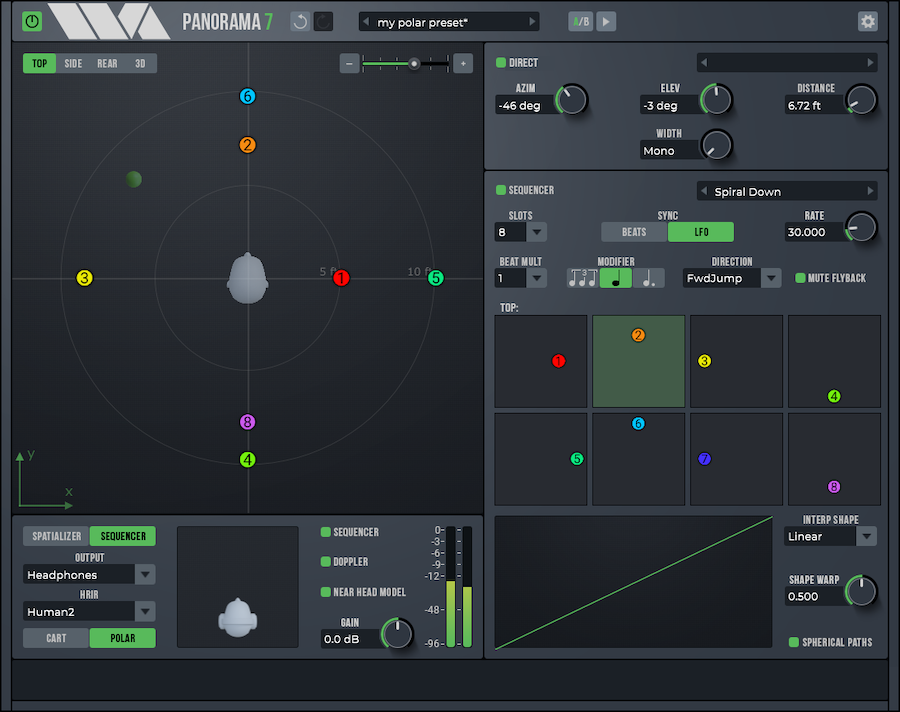
| Back To The Directory |
Wave Arts Panorama 7
By Barry Rudolph
 | |
| Wave Arts Panorama 7 Spatializer Page |
Panorama 7 is a stereo plug-in (AAX,AU, VST 3 hosts) that produces realistic, three-dimensional environments for playback over headphones or loudspeakers. Any stereo audio can be processed through Panorama 7 for synthesizing spaces with virtual walls up to 100 feet away from the listener.
Unlike the conventional power-panning that can only position a sound somewhere between two speakers placed left and right of the listener, Panorama can position sounds as if they came from the sides, rear, above and below the listener. Panorama 7 uses head-related impulse response (HRIR) based binaural synthesis. HRIR synthesis mimics the way we hear and localize sounds in the real world.
Our ears filter incoming sounds caused by the interaction between our bodies, head, and our ear lobes (pinna) to determine the location of sound source as well the ambient characteristics of the space. Using a generic HRIR set known to give good localization results is a way to get an acceptable 3D listening experience without the need for measurement of the individual listener's ears.
Panorama 7 emulates both early room reflections along with late diffusive sound (reverberation) plus Doppler pitch shift and distance modeling. These are all adjustable. Panorama 7 can be inserted on every track in your mix to allow even mono tracks to be positioned anywhere in a three-dimensional space.
GUI
Besides the new, dark look, version 7 as has an enlarged GUI window with the default view looking down from the ceiling depicting a square room floorplan with a binaural "head" placed in the center listening position. Besides this Top view, there are also Side (of the head), Rear (behind the head) views, and the 3D view shows the room from all angles that you can click and drag and for seeing all sides. The new version allows the distance of the walls to the listener to be adjusted down to 5-feet using the Zoom tool.
The surround room head has controls to set the physical size of the room using the Zoom tool. And there are two speakers left and right in front of the head. Changing the width will move these virtual speakers further apart or closer together.
When first starting Panorama 7, you should check the manual to understand the "language" and terms used in binaural/immersive mixing, then decide the output: either speakers or headphones. Since I mostly I mix Pop music that is played on both earbuds and speakers, I opted to set the Output to headphones. An although listening on speakers, whist set to headphones is not perfect--there are some "phase" issues so I made it a workflow step to always check monitoring in L+R mono. I also add the same track in parallel (duplicated) without Panorama as a work around, since there is no easy-to-use, Wet/Dry control on Panorama 7.
If you want to use the Loudspeakers mode, I started out using the 30-degree angle, which is the listener's position in equilateral triangle measure from the center-line passing through the head. There are also 10, 20, 30, and 40-degree choices--the 20-degree choice is good for laptop speakers. I tried the 20-degree angle for a pair of small cubes on my desktop and it worked great. The angle choice optimizes the output for your setup and is saved with the preset.
Note: Loudspeaker output is not fully compatible with both headphones and speakers. The immersive effect is more intense on headphones since the crosstalk canceller (require for loudspeakers) that mixes sound from both the left and right speakers is turned off.
Spatializer
Panorama 7 has a two-layer GUI for the Spatializer and the Sequencer. The Spatializer is for setting up the individual objects or waypoints--specific sounds within the 3D space.
The Spatializer layer is comprised of four modules each with on/off switches (bypass). I liked experimenting here by trying different combinations and settings of these modules.
Direct Sound
The Direct sound's source and position are adjustable within the 3D space. For positioning, you can use either Cartesian coordinates (x, y, z) or Polar with azimuth, elevation and distance parameters. The default is Cartesian. I sometimes muted Direct sound when I only wanted Panorama as an effect return like a conventional delay or reverb plug-in. Check the separate set of presets for this section with descriptive names like: Left Top Front for seeing and position the Direct sound source on the GUI. I'm sure post-production mixers would use these fixed-positions for replicating certain locations in a film so it always feels the same to the viewer.
Reflections
The Reflections module has the ability to change the materials of walls, floors and ceilings that will produce different RT60 values. There controls to set the relative level of the Left, Right, Front, Rear, Top (ceiling) and Bottom, and their distance from the listening position using a separate fader for each. Again, go through the presets for this section as you design crazy-shaped rooms impossible to build physically.
Reverb
The Reverb module also has a collection of room reverb presets you can add into the Spatialization mix. I liked that you can specify the frequencies of both the early and late damping, the RT60 time and size so as to shape the reverb to the synthesized space.
The Spatialization mixer has controls for the level of the Direct, Reflections and Reverb and they include separate Dist-Rolloff controls. Not a filter, Dist-Rolloff is a parameter for applying attenuation while increasing distance. Real-world attenuation would be -6 dB for doubling distance but the defaults are set to -4 dB, just make sure the effect is well-heard. The Reverb level changes very little when the distance is increased/decreased, it defaults to -1.5dB.
I work in Pro Tools HDX Ultimate on a new Mac and the plug-in automatically converts any mono track to stereo although I could not Option drag an instance of an already mono-to-stereo Panorama track to a mono track--you have to insert Panorama each mono or stereo track. Once completed, you may start positioning each track individual anywhere in a three-dimensional space.
HRIR
There are six HRIR or Head-Related Impulse Response available that each have different attributes and shortcomings. The Human HRIR was measured on a human subject, Human2 was measured on Panorama's author, Kemar is from MIT Media Lab, Stereo Pan, which is conventional stereo panning without interaural time delay, Stereo Pass-thru that bypasses the binaural synthesis, and Factory that has a huge collection of HRIRs you can try out.
 | |
| Wave Arts Panorama 7 Sequencer |
Sequencer
The other layer is called the Sequencer and it is all-fun! Sequencer programs the movements of the sound in the space by defining up to eight fixed waypoints (numbered 1 thru 8), which can be arranged around the listening position for fly-bys and dynamically changing the way the room you've created changes. The new auto-panning sequencer is programmable; the sequence of sounds traveling between waypoints can beat-sync'd to the session BPM tempo (read automatically) or free-running using an adjustable LFO. You can start/stop the movement and there is a window to show the current waypoint coordinates.
Beat sync has several choices: dotted quarter note, quarter note, or quarter note triplets. The Beat Multiplier is for speeding up or slowing down movements by a factor of two. Beat Modifier selects: x2/3 for triplets, 1 for beats, and x3/2 for dotted notes. I think this tempo sync interface could be re-designed to be more musical and a little less complicated, as you find in most delay plug-ins.
Setup
Super wide mixes are easy to do using one of the supplied presets with modifications possible in real-time. For auto-panning, I used spherical paths--arc paths rather than straight so there is constant distance from the head to a waypoint. This will prevent huge volume changes when the sound trajectory passes through the head.
In the Sequencer module there are three Shapes with a way to warp or contort the trajectory of a moving waypoint. The waypoint can be move either in a straight line or Linear, Exponential and Sinusoidally (sine wave shape) paths. You can also select Spherical for circular arcs instead of straight paths. Again, check the presets and you'll love it!
Uses For Panorama 7
Here are just a few uses; I've only had this software for little while. I've been using this plug-in on reverb and delay effect returns since it puts any effect outside of the regular stereo field. Plus, reverbs are generally phase incoherent anyway. I have used it for widening stereo pads and keyboards but stay away from percussive instruments since you might hear "flams" as the transients bounce around the simulated room. A cool effect is to drag a sustain instrument and hear a noticeable doppler pitch shift--a little of this effect goes a long way! Needless to say, you can spin an object around the head quickly to create a nauseous feeling!
During a mix session, my routine would be experiment and save as a preset but know the following parameters are not saved for various reason. You cannot save the Current view, Zoom factor, Spatializer/Sequencer display, Cartesian/Polar mode among others. Not really a problem, I would just type those in a text doc and store it in session folder along with other recall information.
A Whole New World of Effects!
Panorama 7 has been a great new very different tool for mixing music. I'm just getting started with using it and I can highly recommend it. Kudos to MIT Media Lab's Ph. D, Bill Gardner and Jeremy Caulfield.
Wave Arts Panorama 7 sells for $129 and is downloadable at: Wave Arts Panorama 7
The manual includes an astute treatise on 3D Audio, HRIR, Binaural Synthesis, Non-Individualized HRIRs and much more.
|
|
|